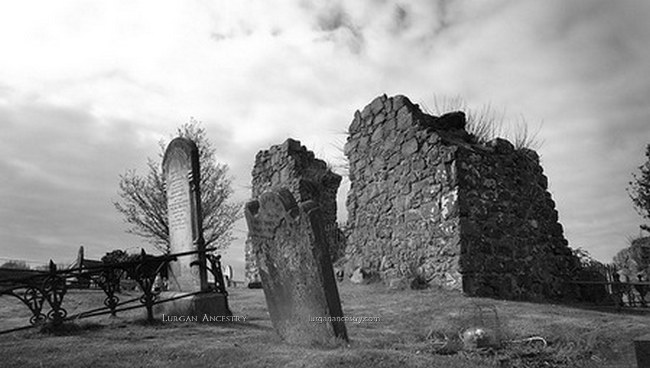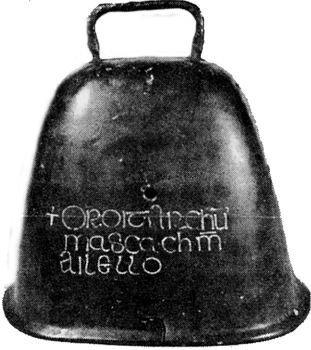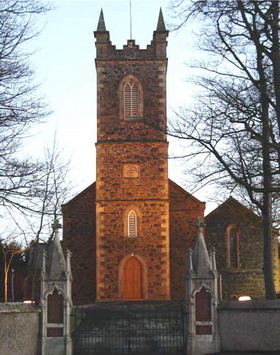Seagoe Parish
By Frank McCorry

The Parish of Seagoe forms part of the Barony of Oneiland East and lies due south of Lough Neagh with the Upper Bann as its western boundary. In its original form, Seagoe was extensive, stretching from the Bann bridge, at Portadown, to Silverwood, on Lurgan's town boundary, a distance of six miles. From Hacknahay, in the south of the parish, to Ardmore,in the north, is eight miles. Until the end of the 18th. century, Seagoe took precedence within the Dromore Diocese over Shankill Parish perhaps on account of its greater antiquity as a religious foundation. Even today while gazing from a distance within Old Seagoe graveyard towards the mound on which the old church ruin stands, the outline of the large double-ringed rath, which formed the nucleus of the original foundation, remains visible. David Riley stated that Seagoe was one of the most ancient Christian settlements in Ireland, dating from c.540 A.D. A large stained glass window in Seagoe Church of Ireland depicts Saint Gobha who is attributed with the foundation of the site. The Reverend Bernard J. Mooney wrote, concerning Saint Gobha:
Reeves was the first modern scholar to perceive that the last element in the place-name is a saint's name, Gobha. Nothing is known of this St. Gobha beyond the fact that he was associated with ancient Seagoe (probably as its founder). The fullest reference to him is that given by Colgan citing the Calendar of Cashel, where his name is Latinised Gobanus. The passage may be translated: `St. Gobanus of Killamery (Co. Kilkenny), near the mountain called Slievenaman; or else Gobanus (Goba) of Teg da-goba (Seagoe), on the bank of the Bann, in Iveagh of Ulidia. Whichever of these it is, he was the (spiritual) father of a thousand monks' (Colgan, A.SS.,750b).
Patrick Keenan added that `information about the ecclesiastical history of Seagoe prior to the l7th.century is woefully scanty. Indeed, from the days of St.Gobha until the year 1406, not even the name of one of his successors as pastor has been discovered'. In 1440, the income from Seagoe Parish was so small that it could not support a parish priest, so it was united to a neighbouring parish, Enachloisgy, the two parishes being described as being at a moderate distance from each other and insufficient to support two pastors. Fifty years later, in 1492, further consolidation of parishes was approved, and Seagoe (Taydagoba), Shankill (Kylmilan) and Aghalee (Acadle), were united. Shankill and Seagoe remained united, under Catholic aegis, from 1492 until 1788.
The vicarage of Enachloisgy is now not known but on Oxford Island, in the townland of Annaloiste, the remains of an ancient church and cemetery were uncovered in 1968, and excavated by the archaeologist, Pat Collins. It was most interesting to discover in Seagoe Church of Ireland parish registers that right up until the middle of the 19th.century, some families from Annaloiste were marrying and baptising in Seagoe, some four miles distant, although the spire of Shankill Church, in Lurgan, was well within sight from their homes. This may well have been the result of rural parish allegiances formed two centuries earlier.
 The Bell of Seagoe, is one of four names attributed to this bell. The inscription in Irish assists in approximating the age of the bell, and to speculate on the background of its keepers. The inscription, 'Oroit ar Chumascach m Ailello' - A prayer for Commascach son of Ailill. The death of this Cumascach, the Economist of the Cathedral of Armagh, is recorded in the Annala Rioghachta Eireann at the year 904, which might infer that the bell is eleven hundred years old this year. Cumascach's mother, Gormlaith, was a daughter of Murdach, King of Ulster. The Bell of Seagoe was kept in the parish for approximately one hundred years, 1730-1830, and is now on display in the National Museum of Ireland, Dublin, alongside the Bell of Saint Patrick. The Bell of Seagoe, is one of four names attributed to this bell. The inscription in Irish assists in approximating the age of the bell, and to speculate on the background of its keepers. The inscription, 'Oroit ar Chumascach m Ailello' - A prayer for Commascach son of Ailill. The death of this Cumascach, the Economist of the Cathedral of Armagh, is recorded in the Annala Rioghachta Eireann at the year 904, which might infer that the bell is eleven hundred years old this year. Cumascach's mother, Gormlaith, was a daughter of Murdach, King of Ulster. The Bell of Seagoe was kept in the parish for approximately one hundred years, 1730-1830, and is now on display in the National Museum of Ireland, Dublin, alongside the Bell of Saint Patrick.
Under Catholic aegis, bonds of unity between Seagoe and Shankill were always strong, and socioeconomic and ecclesiastical associations always close. This was particularly true during the 19th. century when two illustrious parish priests, Reverend Laughlin Laurence Morgan, in Seagoe, and Reverend William O'Brien, in Shankill, worked tirelessly and effectively for almost half a century in their respective parishes to raise living and moral standards. Each parish was heavily populated; each parish needed churches and schools; each catered for a considerable number of poorer families, and kinship links bound the districts together. When the Great Famine came, Seagoe and Shankill, for a variety of reasons fared better than most parishes during that period of great distress and high mortality.
In Seagoe, the weaving of linen and associated trades were widely practised. This often took the emphasis off agricultural improvements. This in turn was in part responsible for the small and fragmented nature of many holdings. Seagoe was so large a parish that it held at least four distinctive population groupings, these arising as the result of the nature of the land which differed much from one locality to the other, and also from the major population adjustments which had to be made in the wake of Anglican in-migration in the 1670-1710 period, and the aftermath of the Battle of the Diamond in 1795.
On the southern Lough Neagh shore, east of the Upper Bann, the district known as 'the Montiaghs' - from the Irish, Montiagh Ruadh (the Red Bog), comprised almost 6,000 acres in ten townlands. Subject to severe winter flooding every year, the Montiaghs held almost half of Seagoe's Catholic population, emanating from families which had occupied the larger area of Clanbrassil for hundreds of years. Turf-cutting, fishing, weaving and pocket-farming sustained these families throughout the 18th. and 19th. centuries. When the Great Famine came, this district, in spite of obvious disadvantages, increased in population during that destructive decade, and went on to register a substantial population increase over the following ten-year period. Marriage and marriage numbers can often be good indicators of the extent of well-being or the lack of it within a parish. In 1847, the most cruel of the Famine years, only seven Catholic marriages were solemnised in the whole of Seagoe Parish.
The greatly diminished marriage number for 1847 is not unexpected. A mere seven marriages in the entire parish means that a sense of dread and vulnerability had spread throughout the extensive parish. Those which were solemnised took place towards the latter part of the year. In later years, right up until the middle of the 20th. century, it was the aim in the Montiaghs to have some new potatoes dug before the end of July. This may have had some relevance to late-in-the-year weddings. It should also be said that Montiagh Church of Ireland marriage numbers were equally curtailed.
 However, the main feature of Seagoe Catholic marriage numbers is the scale and rapidity of the recovery in marriage numbers from 1849 onwards. The mid-summer figures for 1850, and the `high' of 45 marriages in 1853, do not at first reading appear to characterise the Irish parish of the post-Famine period. Marriages were celebrated as if the Famine period had been consigned to history and that life was unaltered. S.H. Cousens may have found a parallel elsewhere; he stated that something of the pre-Famine demographic pattern survived in the poorest and least fertile parts of western Ireland. This same approach to survival may also have been adopted locally. For the time being, Montiagh and Seagoe people may have placed their trust in their cluster of material supports which comprised the availability of turf, fish and wild fowl, as well as the dearly-bought benefits of cottage linen weaving. Thus, the weddings continued, in even greater numbers than before. However, the main feature of Seagoe Catholic marriage numbers is the scale and rapidity of the recovery in marriage numbers from 1849 onwards. The mid-summer figures for 1850, and the `high' of 45 marriages in 1853, do not at first reading appear to characterise the Irish parish of the post-Famine period. Marriages were celebrated as if the Famine period had been consigned to history and that life was unaltered. S.H. Cousens may have found a parallel elsewhere; he stated that something of the pre-Famine demographic pattern survived in the poorest and least fertile parts of western Ireland. This same approach to survival may also have been adopted locally. For the time being, Montiagh and Seagoe people may have placed their trust in their cluster of material supports which comprised the availability of turf, fish and wild fowl, as well as the dearly-bought benefits of cottage linen weaving. Thus, the weddings continued, in even greater numbers than before.
The net result was that in the Montiaghs, the district's population increased from 3,581 people, in 1851, to an extraordinary figure of 4,338, in 1861. No new industries came; no new development schemes were initiated. All that happened was that no adjustments were made to the demographic approach of the pre-Famine era. Burial numbers were down. The weakest had gone (in the Montiaghs, mainly the elderly). Following on from increased marriage numbers, baptisms rose accordingly. And then two decisive factors came into play. Firstly, a set of poor harvests set in, brought about by six years of adverse weather conditions. Secondly, the need or desire to seek a better life elsewhere was felt in Seagoe, and in the Montiaghs, particularly. Rural depopulation began in earnest, its magnitude disguised by decadal census figures.
The adverse weather conditions were:
-
1859: heavy rains, severe drought, heavy rains;
-
1860: heavy rains;
-
1861: heavy rains, worse than the previous year;
-
1862: heavy rains, very wet and cold;
-
1863: severe drought, then torrents of rain;
-
1864: intense drought throughout the summer.
These unfavourable conditions compounded the major disadvantages which prevailed on the Montiaghs even in an average year. This contributed greatly to a 33% increase in burial numbers during the period 1859-64, using 1856-58 as the mean. An exodus from the district began almost immediately. It is probable that the post-Famine growth in population which had raised the population figure to 4,338 in 1861, was the very limit which a boggy district could support on a mainly small-holding economy bolstered up by cottage weaving, turf digging and fishing.
There was a strong fishing tradition in the Montiaghs, particularly among Catholics. Its strength during the mid-19th. century period cannot be quantified. In the early 1900s, nineteen fishing boats operated from the Bay Shore, in Derrytagh North and Derrytrasna. Eels, pollan and trout were the main catch. The pollan season ended at Hallow'een, and the penalty for fishing after this date was much feared. However, pollan could be part of the winter diet, preserved by a simple and effective method. Just prior to Hallow'een, a considerable part of the pollan catch was gutted, and the fish strung out through a scallop (a willow rod) which was put through `the eye', i.e. through the gill to the mouth. The scallop was then wedged into the large open chimney where the fish were dehydrated and smoked, becoming hard and black in colour.
It is remarkable that throughout this difficult period, Catholic and Church of Ireland marriage trends were quite similar. The post-Famine rapid recovery of both communities could not have been anticipated. Neither could the continuation of high marriage rates until c.1860 have been predicted. The attitude of the people had manifested little change. Neither had the terrain, in spite of Lough Neagh's winter level being somewhat lower. Flooded fields and wet turf-banks remained. Church of Ireland farms were generally larger and on higher ground and this can partly explain a decadal recovery in Church marriage numbers during the 1860s. The exodus from the Montiaghs in the 1860s is more clearly reflected in the marriage numbers than in census figures. Obviously those of marriageable age departed in considerable numbers. Yet, in 1871, the district remained heavily populated, to an even greater degree than it had been in the immediate pre-Famine era (based on the census figure of 1841). A strategy was slowly unfolding to combat poverty, and its implementation was proof, if proof were needed, that widespread poverty remained in the district.
The strategy involved relocation, in particular to Derrytagh North, a small townland of almost virgin bogland joined to Lough Neagh by a sandy foreshore.
Derrytagh North had no separate identity until the later-19th. century period. In spite of its size and the nature of its ground, the townland's population was given as 625 in 1871, this being 16% of the overall district's population, dwelling on a mere 4% of its area. This was the result of a population increase of 45% in 1841-51, followed by a 78% increase in the following decade. Those who moved, many from Ballynery, firstly dug down through the turbary to a considerable depth, and then worked this reclaimed land in very small holdings of roughly one acre in extent. The townland was criss-crossed by narrow roads and ramparts, and was the centre of the district's fishing community. Even with a basic supply of food, and fuel literally underfoot, it was inevitable that people would leave Derrytagh North, and by 1881, the population had declined to 541. Our thanks to Frank McCorry for the use of this article.


|

